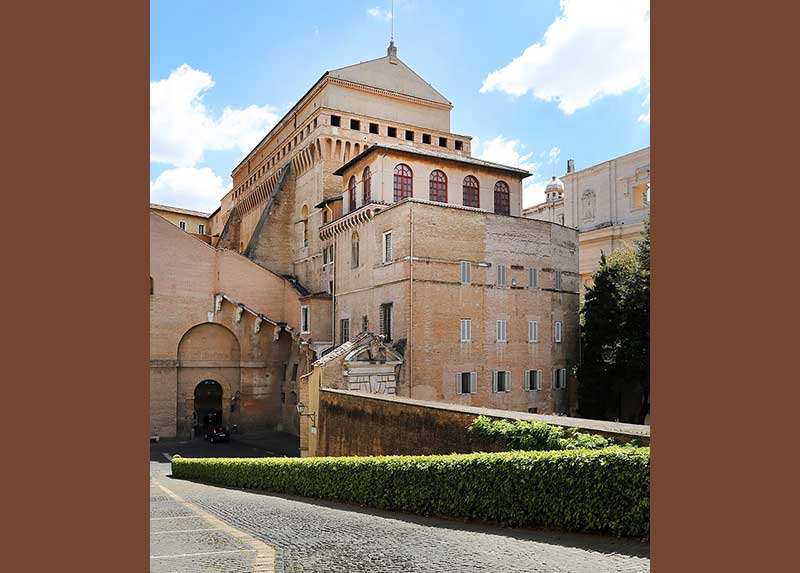
Designed by Baccio Pontelli and built under the supervision of Giovannino de Dolci, Cappella Sistina, widely known as, the Sistine Chapel, was constructed between 1473 and 1481 and was named after Pope Sixtus IV, who commissioned it. Basically, it is a chapel in the Apostolic Palace or the official residence of the pope in Vatican City, constructed on the site of the Cappella Maggiore, which is recorded as existing as early as in 1368. As the age old church was in a ruinous condition with its walls leaning alarmingly, it became an urgent necessary to replace it.
Outwardly, the unadorned robust structure of the chapel with its powerful walls and menacing ramparts seems to be almost awesome, as if engaged in guarding some priceless treasure. In fact, the massive, as well as unimpressive structure of the chapel is a treasure trove, which was enriched with inestimable frescoes created by a number of the most famous artists of the High Renaissance, which include Sandro Botticelli, Pietro Perugino, Domenico Ghirlandaio, Cosimo Rosselli, Luca Signorelli and above all, Michelangelo.

The Sistine Chapel is a high rectangular brick building and its unadorned exterior is devoid of a façade or exterior processional doorways. The ground floor of the three storey building is a very tall basement level, equipped with several utilitarian windows and a doorway giving onto the exterior court.
The robustly vaulted basement supports the Sistine Chapel, constructed above the main space. The measurement of its interior resembles to that of the Temple of Solomon, as depicted in the Old Testament. The building had six tall arched windows down each side and two at either end, several of which have been blocked from time to time. Originally, the barrel vault was painted brilliant-blue and dotted with gold stars, which was later totally replaced by Michelangelo, when he started to work on the ceiling in 1508.



After the completion of a series of frescos depicting the Stories of Moses on the southern wall and the Stories of Jesus on the northern wall by the great artists like, Botticelli, Perugino, Ghirlandaio, Rosselli and Pituricchio in 1482, the first mass in the Sistine Chapel was celebrated by Pope Sixtus IV on 15 August 1483, the Feast of the Assumption, at which the chapel was consecrated and dedicated to the Virgin Mary.


The Sistine Chapel is undoubtedly a masterpiece of the great Michelangelo, who was commissioned by Pope Julius II, to decorate the vault of the chapel with a geometric ornament and surround the decoration with the twelve apostles placed in spandrels. However, initially he rejected the commission, considering it a huge work. He also apprehended that probably he had been recommended for this work by his rivals to see him fail, since during that time, the technique of the fresco was almost unknown. However, after his initial hesitation, Michelangelo finally agreed to the proposal and suggested to paint the Old Testament scenes now found on the vault, divided by the fictive architecture that he uses to organize the composition. The scenes, divided into three sections, begin at the altar.
In his first three paintings, Michelangelo depicted the story of the Creation of the Heavens and Earth, followed by the Creation of Adam and Eve and the Expulsion from the Garden of Eden and finally, the Story of Noah and the Great Flood. The master artist took four years to complete his brilliant work, from 1508 to 1512, lying on a hammock and getting his face sprayed with paint, creating a work of art unprecedented that would change the course of Western art. He was the first artist, who in the chapel depicted God as an old man with a muscular body and a long white beard, which is very similar to the Greek god Jupiter. The Creation of Adam, one of the most famous images of the chapel, located in the central part of the vault and represents the Genesis story in which God gives life to Adam. Much later, he was again commissioned and painted the Last Judgment on the wall above the altar, between 1536 and 1541, for Pope Clement VII and Pope Paul III.

Since its inception, apart from serving as a place of religious activity and the official residence of the Pope, Sistine Chapel also serves as a venue for the election of Pope in a conclave of the College of Cardinals. During a conclave, a chimney is installed in the roof of the chapel, from which white smoke arises as the signal of the election of a new Pope. The fire is created by burning the ballots of the election. However, if a candidate receives less than a two-thirds vote, the cardinals send up black smoke, by burning the ballots along with wet straw.